Page 302 of 474
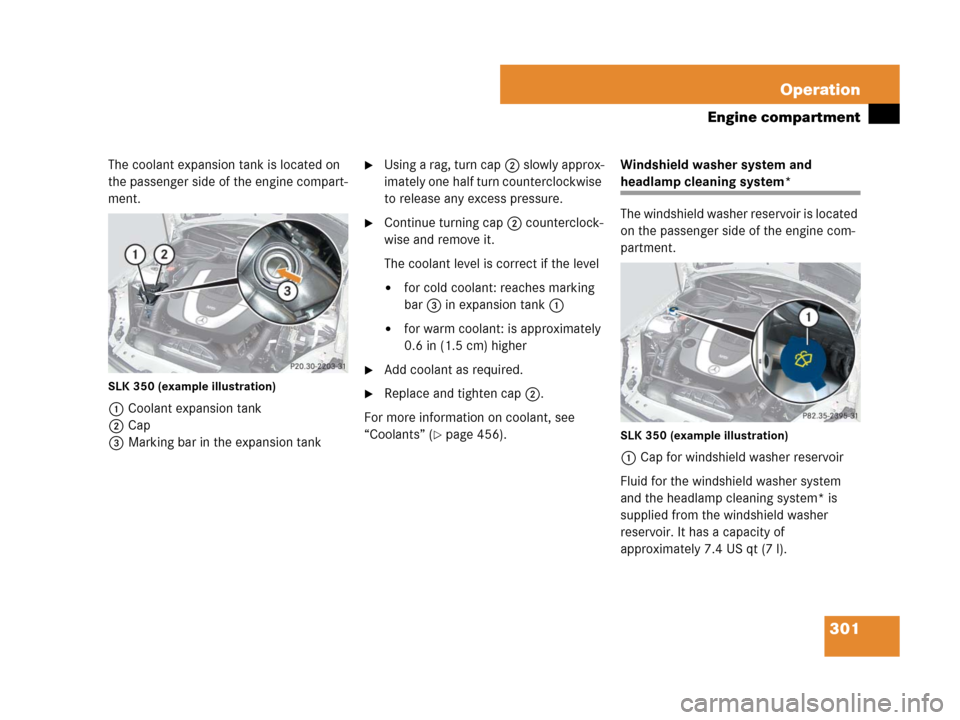
301 Operation
Engine compartment
The coolant expansion tank is located on
the passenger side of the engine compart-
ment.
SLK 350 (example illustration)
1Coolant expansion tank
2Cap
3Marking bar in the expansion tank
�Using a rag, turn cap2 slowly approx-
imately one half turn counterclockwise
to release any excess pressure.
�Continue turning cap2 counterclock-
wise and remove it.
The coolant level is correct if the level
�for cold coolant: reaches marking
bar3 in expansion tank1
�for warm coolant: is approximately
0.6 in (1.5 cm) higher
�Add coolant as required.
�Replace and tighten cap2.
For more information on coolant, see
“Coolants” (
�page 456).Windshield washer system and
headlamp cleaning system*
The windshield washer reservoir is located
on the passenger side of the engine com-
partment.
SLK 350 (example illustration)
1Cap for windshield washer reservoir
Fluid for the windshield washer system
and the headlamp cleaning system* is
supplied from the windshield washer
reservoir. It has a capacity of
approximately 7.4 US qt (7 l).
Page 341 of 474
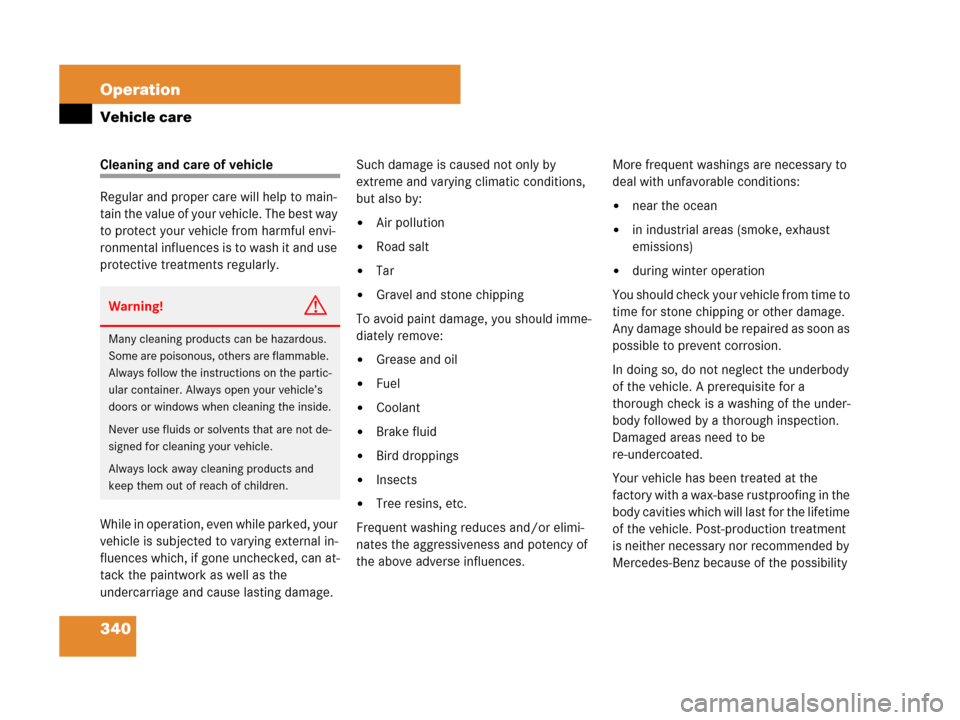
340 Operation
Vehicle care
Cleaning and care of vehicle
Regular and proper care will help to main-
tain the value of your vehicle. The best way
to protect your vehicle from harmful envi-
ronmental influences is to wash it and use
protective treatments regularly.
While in operation, even while parked, your
vehicle is subjected to varying external in-
fluences which, if gone unchecked, can at-
tack the paintwork as well as the
undercarriage and cause lasting damage.Such damage is caused not only by
extreme and varying climatic conditions,
but also by:
�Air pollution
�Road salt
�Tar
�Gravel and stone chipping
To avoid paint damage, you should imme-
diately remove:
�Grease and oil
�Fuel
�Coolant
�Brake fluid
�Bird droppings
�Insects
�Tree resins, etc.
Frequent washing reduces and/or elimi-
nates the aggressiveness and potency of
the above adverse influences.More frequent washings are necessary to
deal with unfavorable conditions:
�near the ocean
�in industrial areas (smoke, exhaust
emissions)
�during winter operation
You should check your vehicle from time to
time for stone chipping or other damage.
Any damage should be repaired as soon as
possible to prevent corrosion.
In doing so, do not neglect the underbody
of the vehicle. A prerequisite for a
thorough check is a washing of the under-
body followed by a thorough inspection.
Damaged areas need to be
re-undercoated.
Your vehicle has been treated at the
factory with a wax-base rustproofing in the
body cavities which will last for the lifetime
of the vehicle. Post-production treatment
is neither necessary nor recommended by
Mercedes-Benz because of the possibility
Warning!G
Many cleaning products can be hazardous.
Some are poisonous, others are flammable.
Always follow the instructions on the partic-
ular container. Always open your vehicle’s
doors or windows when cleaning the inside.
Never use fluids or solvents that are not de-
signed for cleaning your vehicle.
Always lock away cleaning products and
keep them out of reach of children.
Page 348 of 474
347 Practical hints
What to do if …
Where will I find...?
Unlocking/locking in an emergency
Opening/closing in an emergency
Replacing SmartKey batteries
Replacing bulbs
Replacing wiper blades
Flat tire
Battery
Jump starting
Towing the vehicle
Fuses
Page 349 of 474
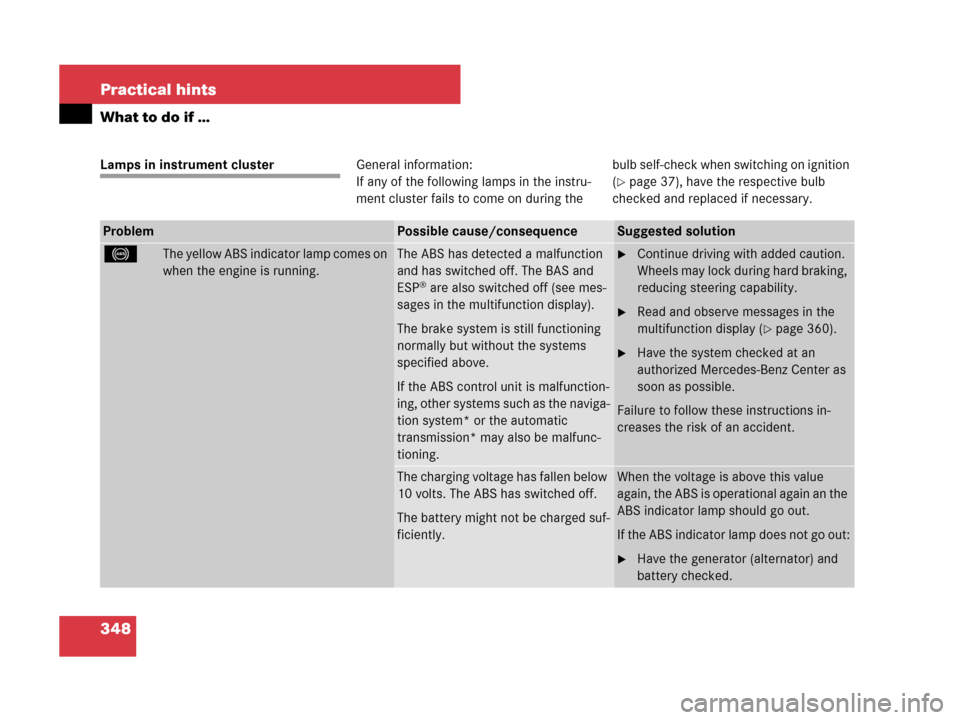
348 Practical hints
What to do if …
Lamps in instrument clusterGeneral information:
If any of the following lamps in the instru-
ment cluster fails to come on during thebulb self-check when switching on ignition
(
�page 37), have the respective bulb
checked and replaced if necessary.
ProblemPossible cause/consequenceSuggested solution
-The yellow ABS indicator lamp comes on
when the engine is running.The ABS has detected a malfunction
and has switched off. The BAS and
ESP
® are also switched off (see mes-
sages in the multifunction display).
The brake system is still functioning
normally but without the systems
specified above.
If the ABS control unit is malfunction-
ing, other systems such as the naviga-
tion system* or the automatic
transmission* may also be malfunc-
tioning.
�Continue driving with added caution.
Wheels may lock during hard braking,
reducing steering capability.
�Read and observe messages in the
multifunction display (
�page 360).
�Have the system checked at an
authorized Mercedes-Benz Center as
soon as possible.
Failure to follow these instructions in-
creases the risk of an accident.
The charging voltage has fallen below
10 volts. The ABS has switched off.
The battery might not be charged suf-
ficiently.When the voltage is above this value
again, the ABS is operational again an the
ABS indicator lamp should go out.
If the ABS indicator lamp does not go out:
�Have the generator (alternator) and
battery checked.
Page 363 of 474
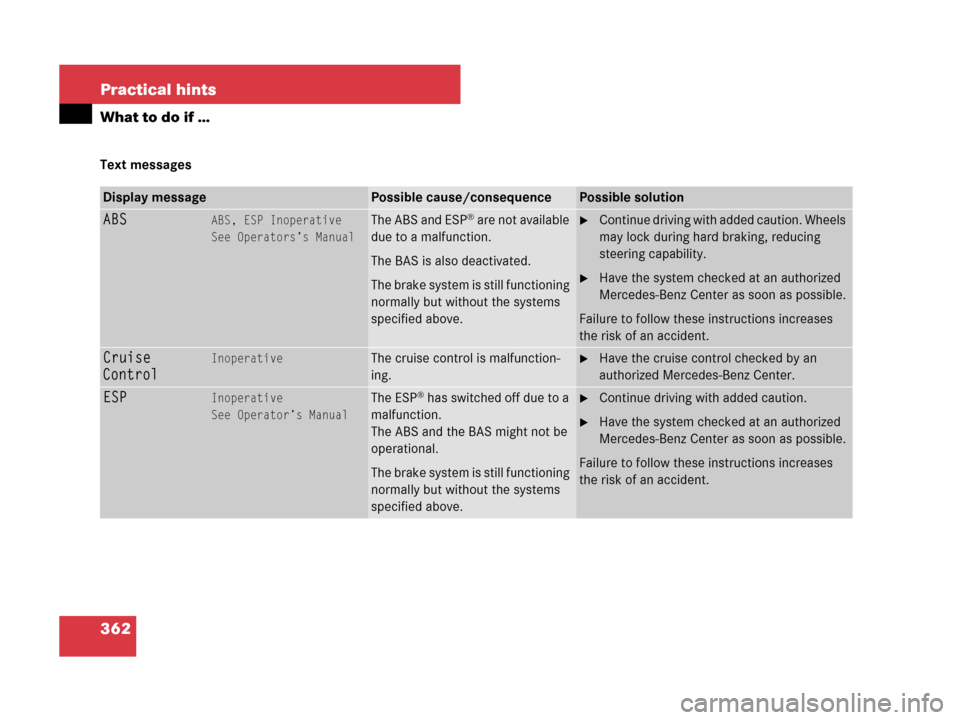
362 Practical hints
What to do if …
Text messages
Display messagePossible cause/consequencePossible solution
ABSABS, ESP Inoperative
See Operators’s ManualThe ABS and ESP® are not available
due to a malfunction.
The BAS is also deactivated.
The brake system is still functioning
normally but without the systems
specified above.�Continue driving with added caution. Wheels
may lock during hard braking, reducing
steering capability.
�Have the system checked at an authorized
Mercedes-Benz Center as soon as possible.
Failure to follow these instructions increases
the risk of an accident.
Cruise
ControlInoperativeThe cruise control is malfunction-
ing.�Have the cruise control checked by an
authorized Mercedes-Benz Center.
ESPInoperative
See Operator’s ManualThe ESP® has switched off due to a
malfunction.
The ABS and the BAS might not be
operational.
The brake system is still functioning
normally but without the systems
specified above.�Continue driving with added caution.
�Have the system checked at an authorized
Mercedes-Benz Center as soon as possible.
Failure to follow these instructions increases
the risk of an accident.
Page 381 of 474
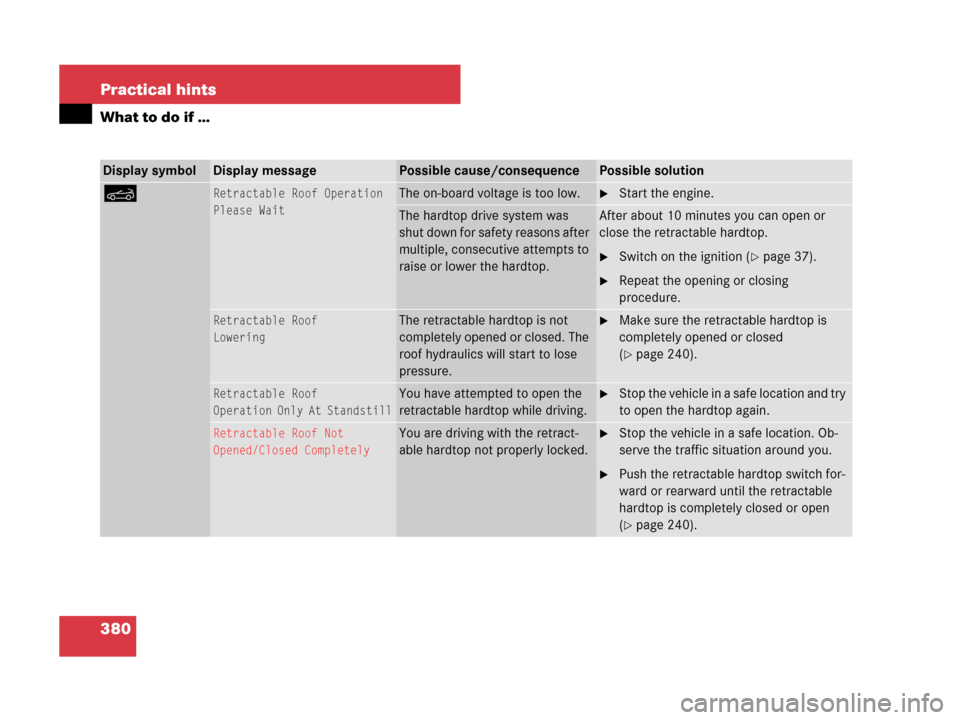
380 Practical hints
What to do if …
Display symbolDisplay messagePossible cause/consequencePossible solution
KRetractable Roof Operation
Please WaitThe on-board voltage is too low.�Start the engine.
The hardtop drive system was
shut down for safety reasons after
multiple, consecutive attempts to
raise or lower the hardtop.After about 10 minutes you can open or
close the retractable hardtop.
�Switch on the ignition (�page 37).
�Repeat the opening or closing
procedure.
Retractable Roof
LoweringThe retractable hardtop is not
completely opened or closed. The
roof hydraulics will start to lose
pressure.�Make sure the retractable hardtop is
completely opened or closed
(
�page 240).
Retractable Roof
Operation Only At StandstillYou have attempted to open the
retractable hardtop while driving.�Stop the vehicle in a safe location and try
to open the hardtop again.
Retractable Roof Not
Opened/Closed CompletelyYou are driving with the retract-
able hardtop not properly locked.�Stop the vehicle in a safe location. Ob-
serve the traffic situation around you.
�Push the retractable hardtop switch for-
ward or rearward until the retractable
hardtop is completely closed or open
(
�page 240).
Page 391 of 474
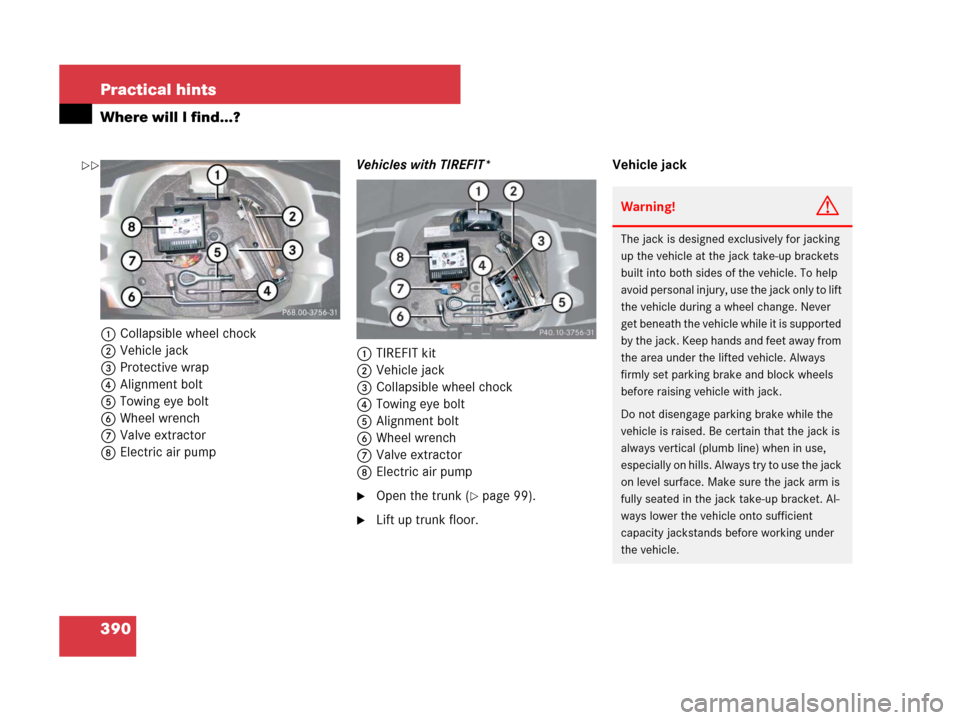
390 Practical hints
Where will I find...?
1Collapsible wheel chock
2Vehicle jack
3Protective wrap
4Alignment bolt
5Towing eye bolt
6Wheel wrench
7Valve extractor
8Electric air pumpVehicles with TIREFIT*
1TIREFIT kit
2Vehicle jack
3Collapsible wheel chock
4Towing eye bolt
5Alignment bolt
6Wheel wrench
7Valve extractor
8Electric air pump
�Open the trunk (�page 99).
�Lift up trunk floor.Vehicle jack
Warning!G
The jack is designed exclusively for jacking
up the vehicle at the jack take-up brackets
built into both sides of the vehicle. To help
avoid personal injury, use the jack only to lift
the vehicle during a wheel change. Never
get beneath the vehicle while it is supported
by the jack. Keep hands and feet away from
the area under the lifted vehicle. Always
firmly set parking brake and block wheels
before raising vehicle with jack.
Do not disengage parking brake while the
vehicle is raised. Be certain that the jack is
always vertical (plumb line) when in use,
especially on hills. Always try to use the jack
on level surface. Make sure the jack arm is
fully seated in the jack take-up bracket. Al-
ways lower the vehicle onto sufficient
capacity jackstands before working under
the vehicle.
��
Page 392 of 474
391 Practical hints
Where will I find...?
The vehicle jack is located in the storage
compartment underneath the trunk floor.
Storage position
�Remove vehicle jack from its
compartment.
�Turn crank handle in the direction of
arrow as far as it will go.
Operational position
�Turn crank handle clockwise.
Before storing the vehicle jack in its
compartment:
�It should be fully collapsed.
�The handle must be folded in (storage
position).Setting up the collapsible wheel chock
The collapsible wheel chock serves to
additionally secure the vehicle, e.g. while
changing the wheel.
1Tilt the plate upward
2Fold the lower plate outward
3Insert the plate